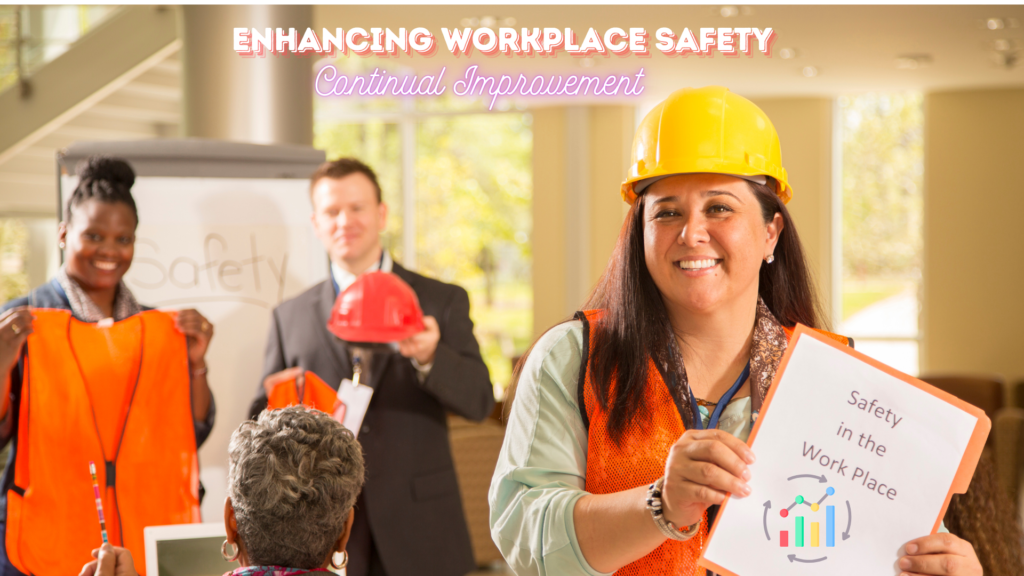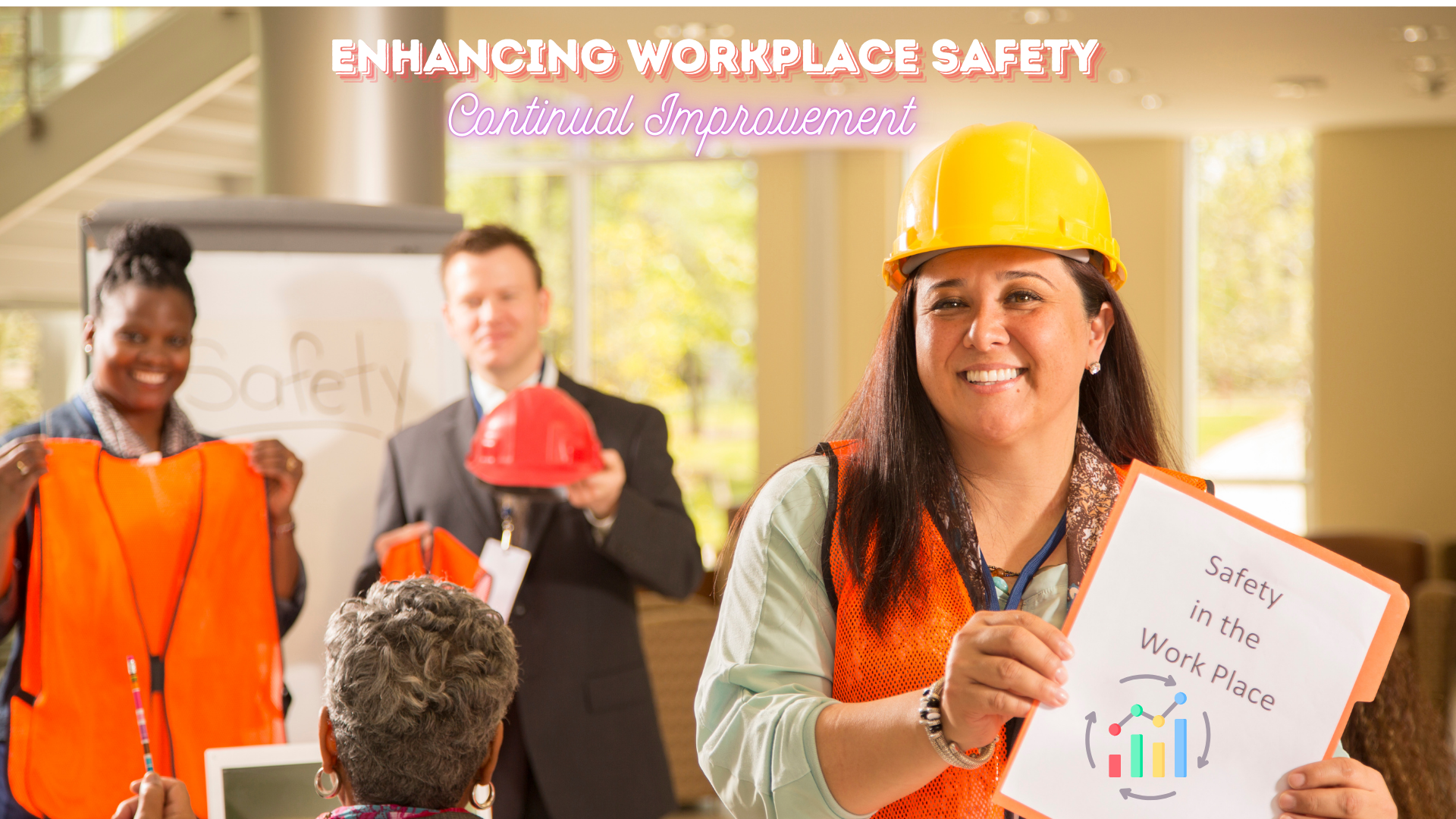As organizations strive to create safer work environments, a continual improvement mindset is essential. Workplace safety is not a one-time initiative, but an ongoing process that requires sustained focus and vigilance. By implementing strategic continual improvement approaches, companies can systematically identify hazards, mitigate risks, and foster a culture of safety throughout the organization. This article will explore key continual improvement strategies that leaders can leverage to enhance workplace safety. We’ll discuss data-driven risk assessment, employee engagement, safety training, and continuous monitoring – all with the goal of driving measurable, long-term improvements in workplace safety performance. Readers will gain actionable insights to help their organizations move beyond reactive, compliance-based safety programs towards proactive, value-adding safety management.

Introduction to Continual Improvement in Workplace Safety
Continual improvement in workplace safety focuses on an ongoing process of identifying, assessing, and mitigating risks. It aims to create a safer, more productive work environment. Key principles include:
- Employee Involvement: Engaging workers in safety practices.
- Management Commitment: Leaders must prioritize safety.
- Training and Education: Regular safety training sessions.
- Risk Assessment: Continuous evaluation of potential hazards.
- Feedback Loop: Collect and act on safety-related feedback.
By prioritizing these elements, organizations can build a proactive safety culture, ensuring the well-being of all employees and enhancing overall operational efficiency.
The Role of Leadership in Promoting Safety
Leadership significantly impacts workplace safety. Effective leaders prioritize safety through clear communication and personal involvement. They establish a safety-first culture by:
- Setting clear safety goals and expectations.
- Regularly participating in safety training sessions.
- Encouraging open communication regarding safety concerns.
- Providing necessary resources and support for safety initiatives.
Leaders demonstrate commitment by:
- Modeling safe behavior consistently.
- Recognizing and rewarding safe practices.
- Holding all team members accountable for safety standards.
Their actions directly influence employees’ attitudes towards safety, ensuring a proactive approach to minimizing workplace hazards.
Establishing a Safety-First Culture
A robust safety-first culture requires a comprehensive approach. Key elements include:
- Leadership Commitment: Senior management must visibly support safety initiatives.
- Employee Involvement: Engage employees in safety planning and decision-making processes.
- Continuous Training: Regular and updated training programs to keep everyone informed about safety protocols.
- Clear Communication: Maintain open lines of communication regarding safety expectations and updates.
- Incentive Programs: Implement reward systems for adhering to safety standards.
- Regular Audits: Conduct periodic safety audits to identify and mitigate risks.
A well-established safety-first culture significantly reduces workplace accidents and enhances overall employee well-being.
Enhancing performance & health and safety culture
Key Leadership Traits that Foster Safety
- Communication Skills: Effective leaders must possess strong communication skills to convey safety protocols and expectations clearly.
- Empathy: Understanding the concerns and needs of employees fosters a culture of trust and openness, essential for reporting hazards.
- Accountability: Taking responsibility for safety outcomes and encouraging the same among team members ensures adherence to safety practices.
- Visionary Thinking: Leaders should have the foresight to anticipate potential safety risks and implement proactive measures.
- Consistency: Maintaining consistent safety standards and practices across all levels of the organization reinforces a culture of safety.
Effective Communication and Training

Effective communication and training are crucial components of workplace safety enhancement. Clear and consistent communication ensures that safety protocols are understood and followed by all employees.
- Regular Training Sessions: Conduct frequent safety training to keep employees updated on best practices and new safety procedures.
- Visual Aids and Signage: Utilize posters, infographics, and signs to reinforce safety messages and procedures.
- Feedback Mechanisms: Implement channels for employees to provide feedback on safety practices and report hazards.
Leadership must lead by example, fostering an environment that prioritizes safety and encourages open dialogue regarding safety concerns.
Implementing Safety Protocols and Procedures
Establishing effective safety protocols and procedures requires a detailed approach:
- Risk Assessment: Conduct regular risk assessments to identify potential hazards.
- Training Programs: Develop comprehensive training programs for all employees.
- Safety Equipment: Ensure availability and accessibility of necessary safety equipment.
- Incident Reporting: Implement a robust incident reporting system.
- Emergency Plans: Create clear emergency response plans and conduct regular drills.
- Compliance Checks: Regularly review and update safety protocols to ensure compliance with regulations.
“Safety isn’t expensive, it’s priceless.” – Author Unknown
Systematic implementation fosters a proactive safety culture, minimizing risks and enhancing overall wellbeing in workplaces.
5 Essential Responsibilities of a Safety Supervisor in Construction
Monitoring and Analyzing Workplace Incidents
Regular monitoring of workplace incidents is crucial for safety. By understanding patterns and causes, organizations can implement corrective actions. Key steps include:
- Data Collection
- Use incident reporting tools.
- Collect comprehensive incident details.
- Data Analysis
- Identify common causes.
- Classify incidents by type and severity.
- Trend Analysis
- Analyze trends over time.
- Detect recurring safety issues.
- Root Cause Analysis
- Investigate underlying causes.
- Use techniques like the 5 Whys.
- Reporting
- Share findings with stakeholders.
- Create actionable safety improvement plans.
Photo of the day: Incident Investigations
Employee Engagement and Participation in Safety Programs
Involving employees in safety programs is crucial for their success. Organizations should adopt the following strategies:
- Regular Training: Conduct regular safety training sessions.
- Feedback Mechanisms: Implement systems for employee feedback.
- Safety Committees: Form safety committees with employee representation.
- Incentive Programs: Develop incentive programs to reward safe behaviors.
- Clear Communication: Ensure transparent communication of safety policies.
Workers who actively participate in these programs are more likely to adhere to safety protocols. Their involvement not only enhances personal responsibility but also fosters a culture of collective safety mindfulness within the organization.
Leveraging Technology for Safety Improvement
Employers can utilize cutting-edge technology to enhance workplace safety measures. Digital tools such as wearable safety devices monitor real-time health statistics and environmental conditions.
- Wearable Technology: Tracks heart rates, detects fatigue, and provides instant alerts for hazards.
- IoT Sensors: Identifies risks related to machinery and air quality.
- Drones: Conducts remote inspections in high-risk areas.
- Safety Apps: Facilitates reporting of unsafe conditions via smartphones.
Augmented Reality (AR) enables immersive training sessions, promoting better comprehension. Leveraging data analytics, companies predict potential safety issues, ensuring proactive measures are in place.
Artificial Intelligence as Your Safety Net: AI Innovations for a Safer Work Environment
Case Studies of Effective Leadership in Reducing Workplace Injuries
A. Toyota
- Leadership prioritized safety culture.
- Implemented Kaizen for continuous improvement.
- Empowered employees to report hazards.
B. DuPont
- Adopted a robust safety management system.
- Used behavior-based safety programs.
- Established clear safety goals and metrics.
C. Alcoa
- CEO Paul O’Neill emphasized safety.
- Introduced “Safety First” practices.
- Recorded a significant drop in incident rates.
D. Shell
- Launched Goal Zero initiative.
- Promoted leadership visibility on safety.
- Implemented thorough incident investigations.
E. Disney
- Created extensive safety training programs.
- Focused on ergonomics and employee wellbeing.
- Fostered a proactive reporting culture.
Overcoming Challenges in Implementing Safety Initiatives
Implementing safety initiatives may face various hurdles. Common obstacles include:
- Budget Constraints
- Limited funds can hinder the purchase of essential safety equipment and training programs.
- Employee Resistance
- Change is often met with resistance. Employees may be reluctant to alter long-standing practices.
- Lack of Management Support
- Without management’s endorsement, safety programs struggle for efficacy and acceptance.
- Inadequate Training
- Insufficient training leads to misunderstandings and incorrect implementations of safety protocols.
- Communication Gaps
- Poor communication can impede the clear transmission of safety policies and procedures.
- Cultural Barriers
- Diverse workforces may bring varied perceptions toward safety, complicating standardization efforts.
Future Trends in Workplace Safety Leadership
- Digital Transformation: Leaders are increasingly leveraging AI and IoT to enhance safety monitoring and incident prevention.
- Remote Safety Management: With more employees working remotely, safety protocols will expand beyond traditional workplaces.
- Data-Driven Decision Making: Advanced analytics will inform safety strategies, identifying risks and trends faster.
- Mental Health Focus: Emphasis on psychological safety will grow as part of a holistic approach to workplace well-being.
- Employee Empowerment: Engagement and training programs will be tailored to encourage active safety participation.
- Sustainability Integration: Environmental safety and health measures will align with broader sustainability goals.
Conclusion and Call to Action
For organizations committed to enhancing workplace safety, continual improvement is vital. By implementing strategic initiatives and regularly assessing their effectiveness, companies can build a safer work environment. To achieve this, consider the following steps:
- Conduct Regular Safety Audits:
- Identify potential hazards.
- Evaluate compliance with safety standards.
- Engage Employees:
- Encourage open communication regarding safety concerns.
- Involve staff in safety planning and training.
- Invest in Training:
- Provide ongoing education on safety protocols.
- Update training methods based on current best practices.
- Leverage Technology:
- Utilize safety management software.
- Implement real-time monitoring systems.
Photo of the day: best workplace safety tips
you may need more resources HERE




